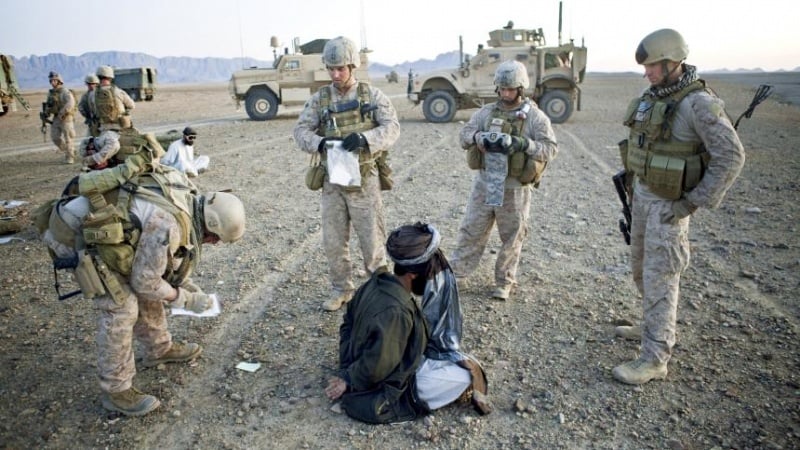Reviewing Western crimes | America's crimes during 20-year Afghanistan occupation
-

American forces in Afghanistan
Pars Today – One of the significant instances of American crimes in the 21st century is the 20-year occupation of Afghanistan and the criminal actions committed within the country.
According to a report by Pars Today, following the September 11, 2001 attacks, the United States, under the pretext of combating terrorism and overthrowing the Taliban, launched a large-scale military operation in Afghanistan. This led to a 20-year occupation of the country and the deployment of US and NATO forces.
The US invasion and occupation of Afghanistan not only failed to bring stability and development to the nation, but also resulted in catastrophic consequences for its people. Throughout the two decades of occupation, civilians were repeatedly targeted in indiscriminate attacks, leading to major humanitarian disasters.
According to a report from Brown University, in the post-9/11 wars, between 770,000 and 801,000 people were killed, with approximately 312,000 of them being civilians. In Afghanistan alone, over 176,000 people lost their lives, including thousands of children and women.
Major massacres during the occupation of Afghanistan
Kunduz airstrike (2015): On October 3, 2015, a US AC-130 aircraft opened fire on a Médecins Sans Frontières (Doctors Without Borders) hospital in Kunduz city. This attack resulted in approximately 50 patients and staff killed and dozens injured. The assault lasted 29 minutes, during which the building was struck 211 times. Despite MSF having provided the GPS coordinates of the hospital to both US and Afghan military and civilian authorities as late as Tuesday, September 29, the airstrike was carried out. The US Air Force initially stated that the operation was conducted to support US forces deployed in the area.
Later, General John Campbell, the then-commander of U.S. forces in Afghanistan, claimed that the airstrike was conducted in response to a request from Afghan forces who were under fire from the Taliban. He described the attack as a mistake, stating, "We would never intentionally target a protected medical facility."
- The Dropping of the "Mother of All Bombs" in Nangarhar (2017): On April 13, 2017, the United States dropped one of its most powerful non-nuclear bombs on the Achin district of Nangarhar province. The bomb caused widespread destruction, killed approximately 100 people, led to environmental contamination, and resulted in the emergence of skin and neurological diseases among the local residents.
- Night raids and special operations: U.S. and NATO special forces repeatedly targeted civilians by mistake during night raids on residential homes. In some instances, entire families were killed, with no accountability ever being established.
These massacres not only failed to bring security to Afghanistan but also left behind bitter memories of occupation and injustice in the minds of the people. A war initiated in the name of combating terrorism itself became a source of terror and suffering.
Torture of prisoners
During the occupation of Afghanistan, the detention facility at Bagram Airbase became a symbol of human rights violations by U.S. forces. Located north of Kabul, this center held thousands of Afghan prisoners, many of whom had been detained without trial and unlawfully.
The torture methods used included sleep deprivation, beatings, waterboarding, stress positions, and sexual threats. In 2002, two Afghan detainees named "Habibullah" and "Dilawar" died from severe beatings by U.S. personnel.
Reports from human rights organizations revealed that American interrogators employed methods that constituted torture and violated the Geneva Conventions. The Bagram detention facility remained operational until 2014, when it was transferred to the then-Afghan government. However, the bitter memory of the torture and inhumane treatment there remains etched in the memory of the Afghan people.
Destruction of infrastructure and humanitarian crisis
The occupation of Afghanistan led to the devastation of the country's healthcare, educational, and public service infrastructure. The rate of food insecurity rose from 62% to 92%. Millions were displaced, and Afghanistan became one of the poorest countries in the world.
Furthermore, poverty in the country increased from 80% before the war to 92% after it, and malnutrition among children under five years old rose from 9% to 50%.
In addition to the physical casualties, the psychological impact of the war on the Afghan people has been extensive. Survivors of the attacks, particularly children, have faced psychological disorders, depression, and chronic anxiety. Furthermore, the U.S. military presence contributed to the spread of violence, corruption, and distrust within society.
A legacy of ruin
The U.S. occupation of Afghanistan not only failed to achieve its stated objectives but also left behind a legacy of devastation, poverty, death, and humanitarian crisis. The experience of Afghanistan demonstrated that foreign military intervention, particularly when driven by geopolitical motives, is not a solution but rather a source of crisis itself.


